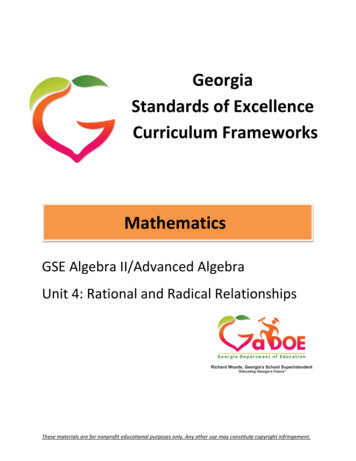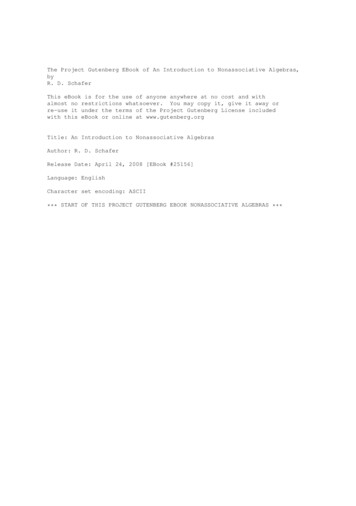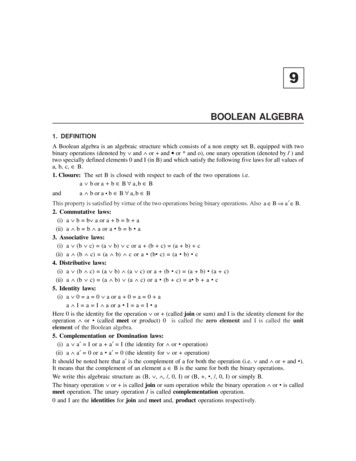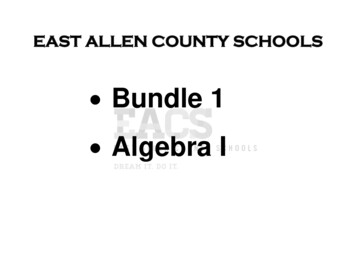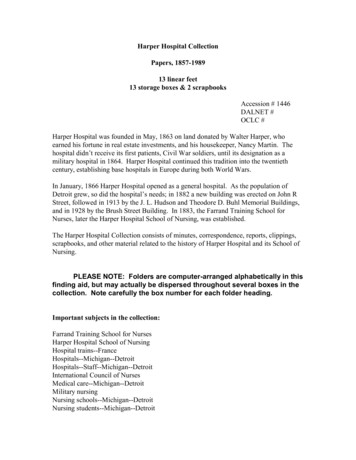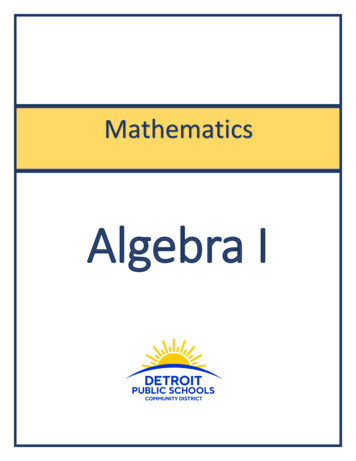
Transcription
MathematicsAlgebra I
2Letter to Families from the DPSCD Office of MathematicsDear DPSCD Families,The Office of Mathematics is partnering with families to support Distance Learning whilestudents are home. We empower you to utilize the resources provided to foster adeeper understanding of grade-level mathematics.In this packet, you will find links to videos, links to online practice, and pencil-and-paperpractice problems. The Table of Contents shows day-by-day lessons from April 14th toJune 19th. We encourage you to take every advantage of the material in this packet.Daily lesson guidance can be found in the table of contents below. Each day has beendesigned to provide you access to materials from Khan Academy and the academicpacket. Each lesson has this structure:Watch: Khan Academy (ifinternet access is available)Practice: Khan Academy (ifinternet access is available)Pencil & Paper Practice:Academic PacketWatch and take notes onthe lesson video on KhanAcademyComplete the practiceexercises on Khan AcademyComplete the pencil andpaper practice.If one-on-one, live support is required, please feel free to call the Homework Hotline at1-833-466-3978. Please check the Homework Hotline page for operating hours. Wehave DPSCD mathematics teachers standing by and are ready to assist.We appreciate your continued dedication, support and partnership with Detroit PublicSchools Community District and with your assistance we can press forward with ourpriority: Outstanding Achievement. Be safe. Be well!Tony R. HawkDeputy Executive Director of K-12 MathematicsPrinted math problems in this packet come from the CPM Educational Program. Open eBook access is available at http://open-ebooks.cpm.org/. 2009, 2014 CPM Educational Program. All rights reserved.
3Important Links and InformationCleverStudents access Clever by visiting www.clever.com/in/dpscd.What are my username and password for Clever?Students access Clever using their DPSCD login credentials. Usernames andpasswords follow this structure:Username: studentID@thedps.orgEx. If Aretha Franklin is a DPSCD student with a student ID of 018765 herusername would be 018765@thedps.org.Password:First letter of first name in upper caseFirst letter of last name in lower case2-digit month of birth2-digit year of birth01 (male) or 02 (female)For example: If Aretha Franklin’s birthday is March 25, 1998, her password andpassword would be Af039802.Accessing Khan AcademyTo access Khan Academy, visit www.clever.com/in/dpscd. Once logged intoClever, select the Khan Academy button:Printed math problems in this packet come from the CPM Educational Program. Open eBook access is available at http://open-ebooks.cpm.org/. 2009, 2014 CPM Educational Program. All rights reserved.
4Accessing Your CPM eBookStudents can access their CPM eBook in two ways:Option 1: Access the eBook through Clever1. Visit www.clever.com/in/dpscd. Login using your DPSCD credentialsabove.2. Click on the CPM icon:Option 2: Visit http://open-ebooks.cpm.org/1. Visit the website listed above.2. Click “I agree”3. Select the CPM Geometry eBook:Desmos Online Graphing CalculatorAccess to a free online graphing and scientific calculator can be found athttps://www.desmos.com/calculator.Printed math problems in this packet come from the CPM Educational Program. Open eBook access is available at http://open-ebooks.cpm.org/. 2009, 2014 CPM Educational Program. All rights reserved.
WeekDateTopicMondayDay 1HolidayDay 24.1.1 WritingEquationsWatch(10 minutes)Online PracticePencil & PaperPractice(25 minutes)N/AN/AN/AConstructLinearEquationsfrom aContextWriting LinearEquations (SlopeIntercept) from aContextProblems 1-5Problems 6-10Write a LinearSystemWrite a Systemfrom a ContextInterpreting aSolution to aSystemInterpret theSolution to aSystemWeekof04/1304/17Day 3Day 44.1.1 WritingEquations4.1.1 & 4.2.1SolvingSystems bySubstitutionSolve aSystem(Substitution)Solve bySubstitutionReviewProblems 1-4
Day 54.1.1 & 4.2.1SolvingSystems bySubstitutionDay 14.1.1 & 4.2.1SolvingSystems bySubstitutionWeekofSystems usingSubstitutionSolve bySubstitutionSolve aSystem withSubstitutionSolve a Systemwith SubstitutionSolve aSystem(Elimination)CombineEquationsProblems 5-8Problems 9-124/204/24Day 24.2.3through4.2.5SolvingSystems byEliminationProblems 1-4EliminationStrategiesDay 34.2.3through4.2.5SolvingSystems byEliminationSolving byElimination withManipulationSolve aSystem withEliminationSolve Systems byEliminationEliminationReview (Article)Problems 5-8
Day 44.2.3through4.2.5SolvingSystems byEliminationSolve aLinear System(Elimination)Systems ofEquations (AllMethodsPractice)EquivalentSystemsEquivalent & NonEquivalentSystemsProblems 9-12NonEquivalentSystemsDay 55.1.1through5.1.3IntroductiontoSequencesIntro toSequencesIntro to Seq.PracticeProblems 1-3Day 15.1.1through5.1.3IntroductiontoSequencesIntro toSequencesIntro to Seq.PracticeProblems 4-5Day 25.2.1through5.2.3EquationsforSequencesEquations forSequencesEquations forSequencesPracticeProblems 1-8Weekof4/2705/01
Day 35.2.1through5.2.3EquationsforSequencesEquations forSequencesEquations forSequencesPracticeProblems 9-14Day 45.2.1through5.2.3EquationsforSequencesEquations forSequencesEquations forSequencesPracticeProblems 15-17Day 55.2.1through5.2.3EquationsforSequencesEquations forSequencesEquations forSequencesPracticeProblems 18-20Day 15.3.1Patterns ofGrowth inTables andGraphsLinear vs. ExpLinear vs. ExpProblems 1-8Day 25.3.1Patterns ofGrowth inTables andGraphsLinear vs. Exp(Context)Linear vs. ExpProblems 9-16Day 37.1.1through7.1.6ExponentialFunctionsExp GrowthFunctionsIntro(Equation)Exp ExpressionsWord ProblemsProblems 1-4Weekof05/0405/08
Exp GrowthWordProblemWriting ExpExpressionsDay ecayWriting ExpDecay EquationsProblems 5-7Day onalExponentPracticeProblems 1-6Day tsFractionalExponentPracticeProblems 7-14Day 27.2.2through7.2.3 CurveFittingCurve FittingCurve FittingPracticeProblems 1-3Day 37.2.2through7.2.3 CurveFittingCurve FittingCurve FittingPracticeProblems 4-5Weekof05/1105/15
Day raticsFactoringQuadraticsPracticeProblems 1-7Day raticsFactoringQuadraticsPracticeProblems 8-14Day raticsFactoringQuadraticsPracticeProblems 15-20Day gShortcutsPracticeProblems 1-5Day gShortcutsPracticeProblems 6-9Weekof05/1805/22
Day gShortcutsPracticeProblems 10-18Day 58.1.5FactoringShortcutsFactoringShortcutsPerfect SquaresProblems 19-23Day gShortcutsPracticeProblems 24-27Day 28.2.2 and8.2.3 Usingthe ZeroProductPropertyZero ProductPropertyZero ProductProperty PracticeProblems 1-5Day 38.2.2 and8.2.3 Usingthe ZeroProductPropertyZero ProductPropertyZero ProductProperty PracticeProblems 6-10Weekof05/2505/29
Day 48.2.2 and8.2.3 Usingthe ZeroProductPropertyZero ProductPropertyZero ProductProperty PracticeProblems 11-15Day 58.2.5GraphingForm andCompletingthe SquareCompletingthe SquareCompleting theSquare PracticeProblems 1-5Day 18.2.5GraphingForm andCompletingthe SquareCompletingthe SquareCompleting theSquare PracticeProblems 6-10Day 29.1.2 and9.1.3 UsingtheQuadraticFormulaUsing theQuadraticFormulaUsing theQuadraticFormula PracticeProblems 1-4Day 39.1.2 and9.1.3 UsingtheQuadraticFormulaUsing theQuadraticFormulaUsing theQuadraticFormula PracticeProblems 5-89.1.2 and9.1.3 UsingtheQuadraticFormulaUsing theQuadraticFormulaUsing theQuadraticFormula PracticeProblems 9-12Weekof06/0106/05Day 4
Day 59.2.1 and9.2.2SolvingOneVariableInequalitiesSolving OneVariableInequalitiesPracticeSolving OneVariableInequalitiesPracticeProblems 1-5Day 19.2.1 and9.2.2SolvingOneVariableInequalitiesSolving OneVariableInequalitiesPracticeSolving OneVariableInequalitiesPracticeProblems 6-10Day 29.2.1 and9.2.2SolvingOneVariableInequalitiesSolving OneVariableInequalitiesPracticeSolving OneVariableInequalitiesPracticeProblems 11-159.3.1 -variableinequalitiesGraphs ofinequalitiespracticeProblems 1-4Weekof06/0806/12Day 3
Day 49.3.1 -variableinequalitiesGraphs ofinequalitiespracticeProblems 5-10Day 59.3.1 -variableinequalitiesGraphs ofinequalitiespracticeProblems 11-13Day 19.3.1 -variableinequalitiesGraphs ofinequalitiespracticeProblems 14-15Day 29.4.1through9.4.3Systems ofInequalitiesIntro tographingsystems ofinequalitiesGraphs ofinequalitiesPracticeProblems 1-3Weekof06/1506/19
Day 39.4.1through9.4.3Systems ofInequalitiesIntro tographingsystems ofinequalitiesGraphs ofinequalitiesPracticeProblems 4-6Day 49.4.1through9.4.3Systems ofInequalitiesIntro tographingsystems ofinequalitiesGraphs ofinequalitiesPracticeProblems 7-8Day 59.4.1through9.4.3Systems ofInequalitiesIntro tographingsystems ofinequalitiesGraphs ofinequalitiesPracticeProblems 9-10
WRITING EQUATIONS4.1.1In this lesson, students translate written information, often modeling everyday situations,into algebraic symbols and linear equations. Students use “let” statements to specificallydefine the meaning of each of the variables they use in their equations.For additional examples and more problems, see the Checkpoint 7A problems at the backof the textbook.Example 1The perimeter of a rectangle is 60 cm. The length is 4 times the width. Write one or moreequations that model the relationships between the length and width.Start by identifying what is unknown in the situation. Then define variables, using “let”statements, to represent the unknowns. When writing “let” statements, the units of measurementmust also be identified. This is often done using parentheses, as shown in the “let” statementsbelow. In this problem, length and width are unknown.Let w represent the width (cm) of the rectangle, and let l represent the length (cm).In this problem there are two variables. To be able to find unique solutions for these twovariables, two unique equations need to be written.From the first sentence and our knowledge about rectangles, the equation P 2l 2w can beused to write the equation 60 2l 2w. From the sentence “the length is 4 times the width” wecan write l 4w.A system of equations is two or moreequations that use the same set of variablesto represent a situation. The system ofequations that represent the situation is:Let w represent the width (cm) of the rectangle,and let l represent the length (cm).Note that students who took a CPM middle school course may recall a method called the 5-DProcess. This 5-D Process is not reviewed in this course, but it is perfectly acceptable forstudents to use it to help write and solve equations for word problems.Using a 5-D table:Trial 1:Trial 2:24DefineWidthLength104(10)DoPerimeter2(40) 2(10) 100DecideP 60?too bigtoo small54(5)2(20) 2(5) 50l4(l)2(4w) 2w 60 2006, 2013 CPM Educational Program. All rights reserved.Core Connections Algebra
Chapter 4Example 2Mike spent 11.19 on a bag containing red and blue candies. The bag weighed 11 pounds. Thered candy costs 1.29 a pound and the blue candy costs 0.79 a pound. How much red candy didMike have?Start by identifying the unknowns. The question in the problem is a good place to look becauseit often asks for something that is unknown. In this problem, the amount of red candy and theamount of blue candy are unknown.Let r represent the amount of red candy (lb), and b represent the amount of blue candy (lb).Note how the units of measurement were defined. If we stated “r red candy” it would be veryeasy to get confused as to whether r represented the weight of the candy or the cost of the candy.From the statement “the bag weighed 11 pounds” we can write r b 11. Note that in thisequation the units are lb lb lb, which makes sense.The cost of the red candy will be 1.29/pound multiplied by its weight,or 1.29r. Similarly, the cost of theblue candy will be 0.79b. Thus1.29r 0.79b 11.19.Parent Guide with Extra PracticeLet r represent the weight of the red candy (lb), andlet b represent the weight of the blue candy (lb). 2006, 2013 CPM Educational Program. All rights reserved.25
ProblemsWrite an equation or a system of equations that models each situation. Do not solve yourequations.1.A rectangle is three times as long as it is wide. Its perimeter is 36 units. Find the length ofeach side.2.A rectangle is twice as long as it is wide. Its area is 72 square units. Find the length ofeach side.3.The sum of two consecutive odd integers is 76. What are the numbers?4.Nancy started the year with 425 in the bank and is saving 25 a week. Seamus started theyear with 875 and is spending 15 a week. When will they have the same amount ofmoney in the bank?5.Oliver earns 50 a day and 7.50 for each package he processes at Company A.His paycheck on his first day was 140. How many packages did he process?6.Dustin has a collection of quarters and pennies. The total value is 4.65. There are33 coins. How many quarters and pennies does he have?7.A one-pound mixture of raisins and peanuts costs 7.50. The raisins cost 3.25 a poundand the peanuts cost 5.75 a pound. How much of each ingredient is in the mixture?8.An adult ticket at an amusement park costs 24.95 and a child’s ticket costs 15.95.A group of 10 people paid 186.50 to enter the park. How many were adults?9.Katy weighs 105 pounds and is gaining 2 pounds a month. James weighs 175 pounds andis losing 3 pounds a month. When will they weigh the same amount?10.26Harper Middle School has 125 fewer students than Holmes Junior High. When the twoschools are merged there are 809 students. How many students attend each school? 2006, 2013 CPM Educational Program. All rights reserved.Core Connections Algebra
Chapter 4Answers (Other equivalent forms are possible.)1.One Variable EquationSystem of EquationsLet Statement2w 2(3w) 36l 3wLet l length, w width2w 2l 362.w(2w) 7l 2wLet l length, w widthlw 723.m (m 2) 76m n 76n m 24.425 25x 875 – 15xy 425 25xy 875 – 15x5.50 7.5p 1406.0.25q 0.01(33 – q) 4.653.25r 5.75(1 – r) 7.5q p 33r p 13.25r 5.75p 7.5(1)8.24.95a 15.95(10 – a) 186.5 a c 1024.95a 15.95c 186.59.105 2m 175 – 3mw 105 2mw 175 – 3m10.x (x – 125) 809x y 809y x – 125Parent Guide with Extra PracticeLet x the number of weeksand y the total money inthe bankLet p the number ofpackages Oliver processed0.25q 0.01p 4.657.Let m the first odd integerand n the next consecutiveodd integerLet q number of quarters,p number of penniesLet r weight of raisins andp weight of peanutsLet a number of adulttickets and c number ofchild’s ticketsLet m the number ofmonths and w the weightof each personLet x number of Holmesstudents and y number ofHarper students 2006, 2013 CPM Educational Program. All rights reserved.27
SOLVING SYSTEMS BY SUBSTITUTION4.1.1 and 4.2.1A system of equations has two or more equations with two or more variables. In theprevious course, students were introduced to solving a system by looking at theintersection point of the graphs. They also learned the algebraic Equal Values Methodof finding solutions. Graphing and the Equal Values Method are convenient when bothequations are in y mx b form (or can easily be rewritten in y mx b form).The Substitution Method is used to change a two-variable system of equations to a onevariable equation. This method is useful when one of the variables is isolated in one ofthe equations in the system. Two substitutions must be made to find both the x- andy-values for a complete solution.For additional information, see the Math Notes boxes in Lessons 4.1.1, 4.2.2, 4.2.3, and4.2.5. For additional examples and more problems solving systems using multiplemethods, see the Checkpoint 7A and 7B problems at the back of the textbook.The equation x y 9 has infinite possibilities for solutions: (10, –1), (2, 7), (0, 9), , but ify 4 then there is only one possible value for x. That value is easily seen when we replace(substitute for) y with 4 in the original equation: x 4 9, so x 5 when y 4. Substitution andthis observation are the basis for the following method to solve systems of equations.Example 1 (Equal Values Method)Solve:y 2xx y 9When using the Equal Values Method, start by rewriting both equationsin y mx b form. In this case, the first equation is already iny mx b form. The second equation can be rewritten by subtracting xfrom both sides:Since y represents equal values in both the first equation, y 2x, andthe second equation, y 9 – x, you can write: 2x 9 – x.Solving for x: 2x 9 x x x3x 9x 3Then, either equation can be used to find y.For example, use the first equation, y 2x, to find y:Example continues on next page 28 2006, 2013 CPM Educational Program. All rights reserved.Core Connections Algebra
Chapter 4Example continued from previous page.The solution to this system of equation is x 3 and y 6. That is, the values x 3 and y 6make both of the original equations true. When graphing, the point (3, 6) is the intersection ofthe two lines.Always check your solution by substituting the solution back into both of the original equationsto verify that you get true statements:For y 2x at (3, 6),?6 2(3)6 6 is a true statement.For x y 9 at (3, 6),?3 6 99 9 is a true statement.Example 2 (Substitution Method)Solve:y 2xx y 9The same system of equations in Example 1 can be solvedusing the Substitution Method. From the first equation, yis equivalent to 2x. Therefore you can replace the y in thesecond equation with 2x:Replace y with 2x, and solve.Then, either equation can be used to find y.For example, use the first equation, y 2x,to find y:The solution to this system of equation is x 3 and y 6. That is, the values x 3 and y 6make both of the original equations true. When graphing, the point (3, 6) is the intersection ofthe two lines.Always check your solution by substituting the solution back into both of the original equationsto verify that you get true statements (see Example 1).Parent Guide with Extra Practice 2006, 2013 CPM Educational Program. All rights reserved.29
Example 3 (Substitution Method)Look for a convenient substitution when using the Substitution Method; look for a variablethat is by itself on one side of the equation.Solve: 4x y 8x 5 ySince x is equivalent to 5 – y, replace x in the first equation with 5 – y.Solve as usual.To find x, use either of the original two equations.In this case, we will use x 5 – y.The solution is (1, 4). Always check your solution by substituting the solution back into both ofthe original equations to verify that you get true statements.Example 4Not all systems have a solution. If the substitution results in an equation that is not true, thenthere is no solution. The graph of a system of two linear equations that has no solutions is twoparallel lines; there is no point of intersection. See the Math Notes box in Lesson 4.2.5 foradditional information.Solve: y 7 3x3x y 10Replace y in the second equation with 7 – 3x.The resulting equation is never true.There is no solution to this system of equations.30 2006, 2013 CPM Educational Program. All rights reserved.Core Connections Algebra
Chapter 4Example 5There may also be an infinite number of solutions. This graph would appear as a single line forthe two equations.Solve: y 4 2x 4x 2y 8Substitute 4 – 2x in the second equation for y.This statement is always true. There are infinite solutions to thissystem of equations.Example 6Sometimes you need to solve one of the equations for x or y to use the Substitution Method.Solve:y 2x 73x 4y 8Solve the first equation for y to get y 2x – 7.Then substitute 2x – 7 in the second equation for y.Then find y.Check:1 2(4) 7 and 3(4) 4(1) 8 .The solution is (4, 1). This would be the intersection point of the two lines. Always check yoursolution by substituting the solution back into both of the original equations to verify that you gettrue statements.Parent Guide with Extra Practice 2006, 2013 CPM Educational Program. All rights reserved.31
Problems1.y 3x4x y 22.y 7x 52x y 133.x 5y 4x 4y 234.x y 10y x 45.y 5 x4x 2y 106.3x 5y 23y x 37.y x 22x 3y 98.y 2x 3 2x y 19.x 12 y y 3 2x4x 2y 612.y x 1x y 110.a 2b 4b 2a 1611.122x y 1Answers1.(2, –6)2.(2, 9)3.(11, –3)4.(7, 3)5.(0, 5)6.(1, 4)7.(3, –5)8.No solution9.(0, –1)10.32(–12, –8)11.Infinite solutions 2006, 2013 CPM Educational Program. All rights reserved.12.No solutionCore Connections Algebra
Chapter 4ELIMINATION METHOD4.2.3 through 4.2.5In previous work with systems of equations, one of the variables was usually alone on oneside of one of the equations. In those situations, it is convenient to rewrite both equationsin y mx b form and use the Equal Values Method, or to substitute the expression forone variable into the other equation using the Substitution Method.Another method for solving systems of equations is the Elimination Method. Thismethod is particularly convenient when both equations are in standard form (that is,ax by c). To solve this type of system, we can rewrite the equations by focusing onthe coefficients. (The coefficient is the number in front of the variable.)See problem 4-56 in the textbook for an additional explanation of the Elimination Method.For additional information, see the Math Notes boxes in Lessons 4.2.4 and 5.1.1. Foradditional examples and more problems solving systems using multiple methods, see theCheckpoint 7B materials in the back of the textbook.Example 1Solve:x y 22x y 1Recall that you are permitted to add the same expression to both sides of anequation. Since x – y is equivalent to 2 (from the first equation), you arepermitted to add x – y to one side of the second equation, and 2 to the otherside. Then solve.Note that this was an effective way to eliminate y and find xbecause –y and y were opposite terms; y ( y) 0 .Now substitute the value of x in either of the original equations to find they-value.The solution is (1, –1), since x 1 and y –1 make both of the original equations true. On agraph, the point of intersection of the two original lines is (1, –1). Always check your solutionby substituting the solution back into both of the original equations to verify that you get truestatements.See problem 4-56 in the textbook for an additional explanation of the Elimination Method.Parent Guide with Extra Practice 2006, 2013 CPM Educational Program. All rights reserved.33
Example 2Solve: 3x 6y 243x y 1Notice that both equations contain a 3x term. We can rewrite 3x y 1 by multiplying bothsides by –1, resulting in 3x ( y) 1 . Now the two equations have terms that are opposites:3x and –3x. This will be useful in the next step because –3x 3x 0.Since –3x (–y) is equivalent to 1, we can add –3x (–y) to one side of theequation and add 1 to the other side.Notice how the two opposite terms, 3x and –3x, eliminated each other,allowing us to solve for y.Then substitute the value of y into either of the original equations to find x.The solution is (–2, 5). It makes both equations true, and names the pointwhere the two lines intersect on a graph. Always check your solution bysubstituting the solution back into both of the original equations to verifythat you get true statements.A more detailed explanation of this method can be found in the following example.Example 3To use the Elimination Method, one of the terms in one of the equationsneeds to be opposite of the corresponding term in the other equation. One ofthe equations can be multiplied to make terms opposite. For example, in thesystem at right, there are no terms that are opposite. However, if the first equation is multipliedby –4, then the two equations will have 4x and –4x as opposites. The first equation now lookslike this: –4(x 3y 7) –4x (–12y) –28. When multiplying an equation, be sure tomultiply all the terms on both sides of the equation. With the first equation rewritten, the systemof equations now looks like this: 4x ( 12y) 284x 7y 10 Since 4x – 7y is equivalent to –10, they can be added to both sides ofthe first equation:Now any of the equations can be used to find x:The solution to the system of equations is (1, 2).34 2006, 2013 CPM Educational Program. All rights reserved.Core Connections Algebra
Chapter 4Example 4If multiplying one equation by a number will not make it possible to eliminate a variable,multiply both equations by different numbers to get coefficients that are the same or opposites.Solve: 8x 7y 53x 5y 9One possibility is to multiply the first equation by 3and the second equation by –8. The resulting terms24x and –24x will be opposites, setting up theElimination Method.The system of equations is now:This system can be solved by adding equivalent expressions (from thesecond equation) to the first equation:Then solving for x, the solution is (–2, –3). For an additional example like this one (where both equations had to bemultiplied to create opposite terms), see Example 2 in the Checkpoint 7Bmaterials at the back of the textbook.Example 5The special cases of “no solution” and “infinite solutions” can also occur. See the Math Notesbox in Lesson 4.2.5 for additional information.Solve: 4x 2y 62x y 3Multiplying the second equation by 2 produces 4x 2y 6. The two equations are identical, sowhen graphed there would be one line with infinite solutions because the same ordered pairs aretrue for both equations.Solve:2x y 34x 2y 8Multiplying the first equation by 2 produces 4x 2y 6. There are no numbers that could make4x 2y equal to 6, and 4x 2y equal to 8 at the same time. The lines are parallel and there is nosolution, that is, no point of intersection.Parent Guide with Extra Practice 2006, 2013 CPM Educational Program. All rights reserved.35
SUMMARY OF METHODS TO SOLVE SYSTEMSMethodEqual ValuesThis Method is Most Efficient WhenBoth equations in y-form.Exampley x 2y 2x 1SubstitutionOne variable is alone on one side of oneequation.y 3x 13x 6y 24Elimination: Add toeliminate one variable.Equations in standard form with oppositecoefficients.x 2y 213x 2y 7Elimination: MultiplyEquations in standard form. One equationone equation to eliminate can be multiplied to create opposite terms.one variable.x 2y 33x 2y 7Elimination: Multiplyboth equations toeliminate one variable.2x 5y 33x 2y 7When nothing else works. In this case youcould multiply the first equation by 3 andthe second equation by –2, then add toeliminate the opposite terms.Problems1.2x y 6 2x y 22. 4x 5y 0 6x 5y 103.2x 3y 9x y 24.y x 42y x 85.2x y 46. 4x 6y 202x 3y 106x 2y 164x y 18.6x y 46x 3y 169.2x 2y 52x 3y 311.4x 4y 1412.3x 2y 127.10.y 2x 6y 2x 412x y 12x 4y 85x 3y 37Answers1.(1, 4)2.(5, 4)3.( 3 , 1)4.(0, 4)5.(2, 0)6.Infinite7.( 1 , 5)8.( 16 , 5 )9.(4.5, 2)12.( 2 , 9)10.36No solution11.(3, 12 ) 2006, 2013 CPM Educational Program. All rights reserved.Core Connections Algebra
Chapter 5INTRODUCTION TO SEQUENCES5.1.1 through 5.1.3In Chapter 5, students investigate sequences by looking for patterns and rules. Initially inthe chapter, students concentrate on arithmetic sequences (sequences generated by addinga constant to the previous term), and then later in the chapter (and in Chapter 7) theyconsider geometric sequences (sequences generated by multiplying the previous term bya constant).In Lessons 5.1.1 through 5.1.3 students are introduced to the two types of sequences,arithmetic and geometric, and their graphs, in everyday situations.For additional examples and explanations, see the next section of this Parent Guide withExtra Practice, “Equations for Sequences.” For additional information, see the first halfof the Math Notes box in Lesson 5.3.2.Example 1Peachy Orchard Developers are preparing land to create a large subdivision of single-familyhomes. They have already built 15 houses on the site. Peachy Orchard plans to build six newhomes every month. Create a table of values that will show the number of houses in the PeachyOrchard subdivision over time. Write an equation relating the number of houses over time.Graph the sequence.Since the subdivision initially has 15 homes, 15 is the number of homes at time t 0. After onemonth, there will be six more, or 21 homes. After the second month, there will be 27 homes.After each month, we add six homes to the total number of homes in the subdivision. Becausewe are adding a constant amount after each time period, this is an arithmetic sequence.n, thenumber ofmonths01234t(n), the totalnumber ofhomes1521273339We can find the equation for this situation by noticing thatthis is a linear function: the growth is constant. Allarithmetic sequences are linear.One way to write the equation that models this situation is tonotice that the slope (growth) 6 homes/month, and they-intercept (starting point) 15. Then in y mx b form,the equation is y 6x 15.Another way to find the equation of a line, especially insituations more complex than this one, is to use two points onthe line, calculate the slope (m) between the two points, and then solve for the y-intercept (as inLesson 2.3.2). This method is shown in the foll
Day 5 5.1.1 through 5.1.3 Introduction to Sequences Intro to Sequences Intro to Seq. Practice Problems 1-3 5.1.3 Week of 4/27-05/01 Day 1 5.1.1 through Introduction to Sequences Intro to Sequences Intro to Seq. Practice Problems 4-5 Day 2 5.2.1 through 5.2.3 Equations for Sequences Equations for Sequences Equations for Sequences Practice







